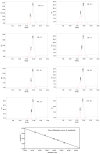Characterization of dextrins with different Dextrose Equivalents
- PMID: 20714293
- PMCID: PMC6257794
- DOI: 10.3390/molecules15085162
Characterization of dextrins with different Dextrose Equivalents
Abstract
Dextrins are widely used for their functional properties and prepared by partial hydrolysis of starch using acid, enzymes, or combinations of both. The physiochemical properties of dextrins are dependent on their molecular distribution and oligosaccharide profiles. In this study, scanning electron microscopy (SEM), X-ray diffractometry (XRD), rapid viscoanalysis (RVA), high-performance Liquid Chromatography (HPLC) and gel permeation chromatography (GPC) were used to characterize dextrins prepared by common neutral and thermostable alpha-amylase hydrolysis. The dextrin granules displayed irregular surfaces and were badly damaged by the enzyme treatment. They displayed A-type X-ray diffraction patterns with a decrease of intensity of the characteristic diffraction peaks. The RVA profiles showed that the viscosity of dextrin decreased with the increase of its Dextrose Equivalent (DE) value. According to HPLC analysis, the molecular weight, degree of polymerization and the composition of oligosaccharides in dextrins were different.
Figures






Similar articles
-
Dextrin characterization by high-performance anion-exchange chromatography--pulsed amperometric detection and size-exclusion chromatography--multi-angle light scattering--refractive index detection.J Chromatogr A. 2003 May 16;997(1-2):79-85. doi: 10.1016/s0021-9673(03)00626-5. J Chromatogr A. 2003. PMID: 12830879
-
Highly branched dextrin prepared from high-amylose maize starch using waxy rice branching enzyme (WRBE).Food Chem. 2016 Jul 15;203:530-535. doi: 10.1016/j.foodchem.2016.02.061. Epub 2016 Feb 10. Food Chem. 2016. PMID: 26948647
-
Fractionation of starch hydrolysates into dextrins with narrow molecular mass distribution and their detection by high-performance anion-exchange chromatography with pulsed amperometric detection.J Chromatogr A. 2003 Apr 11;992(1-2):75-83. doi: 10.1016/s0021-9673(03)00313-3. J Chromatogr A. 2003. PMID: 12735464
-
Enzyme-resistant dextrins from potato starch for potential application in the beverage industry.Carbohydr Polym. 2017 Sep 15;172:152-158. doi: 10.1016/j.carbpol.2017.05.041. Epub 2017 May 17. Carbohydr Polym. 2017. PMID: 28606521
-
Characterization, health benefits, and food applications of enzymatic digestion- resistant dextrin: A review.Int J Biol Macromol. 2023 Dec 31;253(Pt 4):126970. doi: 10.1016/j.ijbiomac.2023.126970. Epub 2023 Sep 18. Int J Biol Macromol. 2023. PMID: 37730002 Review.
Cited by
-
Chemical Compounds of Berry-Derived Polyphenols and Their Effects on Gut Microbiota, Inflammation, and Cancer.Molecules. 2022 May 20;27(10):3286. doi: 10.3390/molecules27103286. Molecules. 2022. PMID: 35630763 Free PMC article. Review.
-
Technological Application of Maltodextrins According to the Degree of Polymerization.Molecules. 2015 Nov 27;20(12):21067-81. doi: 10.3390/molecules201219746. Molecules. 2015. PMID: 26633312 Free PMC article.
-
Sulfaguanidine Hybrid with Some New Pyridine-2-One Derivatives: Design, Synthesis, and Antimicrobial Activity against Multidrug-Resistant Bacteria as Dual DNA Gyrase and DHFR Inhibitors.Antibiotics (Basel). 2021 Feb 5;10(2):162. doi: 10.3390/antibiotics10020162. Antibiotics (Basel). 2021. PMID: 33562582 Free PMC article.
-
Nutraceutical Concepts and Dextrin-Based Delivery Systems.Int J Mol Sci. 2022 Apr 7;23(8):4102. doi: 10.3390/ijms23084102. Int J Mol Sci. 2022. PMID: 35456919 Free PMC article. Review.
-
Effect of the addition of maltodextrin on metabolites and microbial population during kimchi fermentation.J Food Sci Technol. 2023 Aug;60(8):2153-2159. doi: 10.1007/s13197-023-05742-y. Epub 2023 Apr 18. J Food Sci Technol. 2023. PMID: 37273568 Free PMC article.
References
-
- White D.R., Jr., Hudson P., Adamson J.T. Dextrin characterization by high-performance anion-exchange chromatography-pulsed amperometric detection and size-exclusion chromatography–multi-angle light scattering-refractive index detection. J. Chromatogr. A. 2003;997:79–85. doi: 10.1016/S0021-9673(03)00626-5. - DOI - PubMed
-
- Tester R.F., Qi X., Karkalas J. Hydrolysis of native starches with amylases. Anim. Feed Sci. Technol. 2006;130:39–54. doi: 10.1016/j.anifeedsci.2006.01.016. - DOI
-
- Chronakis I.S., Kasapis S., Richardson R.K. Small deformation rheological properties of maltodextrin-milk protein systems. Carbohyd. Polym. 1996;29:137–148. doi: 10.1016/0144-8617(96)00014-8. - DOI
-
- Dokik P., Jakovljevic J., Dokic-Baucal L. Molecular characteristics of maltodextrins and rheological behaviour of diluted and concentrated solutions. Colloids Surfaces A. 1998;141:435–440. doi: 10.1016/S0927-7757(97)00118-0. - DOI
MeSH terms
Substances
LinkOut - more resources
Full Text Sources
Other Literature Sources

